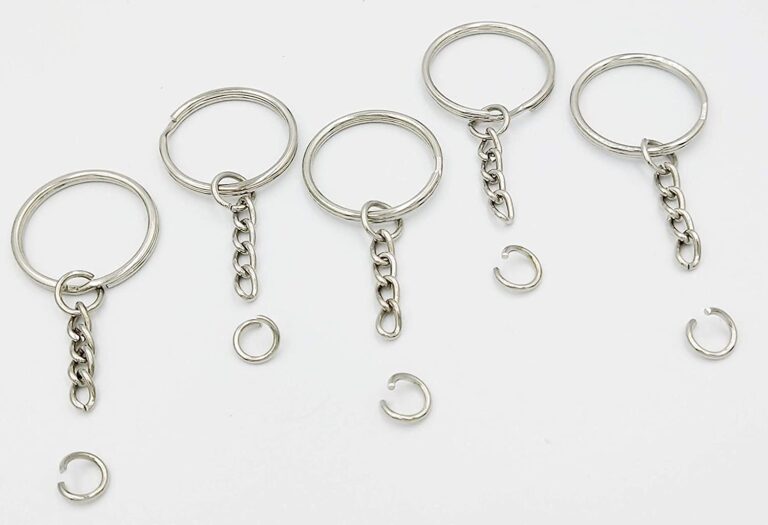When you think of keychains, flashy charms, leather fobs, or engraved tags might come to mind. But behind every reliable keychain is a small yet crucial component: the jump ring. Often overlooked, jump rings are the connectors that hold everything together—literally. Whether you’re making keychains for sale, gifts, or personal use, the quality and type of jump ring you choose can make or break your creation.
In this article, we’ll dive into the essential role jump rings play in keychain design, how to select the right ones, and tips for durability and security.
What Are Jump Rings?
Jump rings are metal loops—either round or oval—that function as connectors. In keychains, they’re typically used to:
-
Attach charms, tags, or accessories to the keyring
-
Link components in decorative chains
-
Add flexibility and movement to multi-part designs
Jump rings may be soldered (closed permanently) or unsoldered (able to be opened and closed with pliers). Each type has its own benefits depending on the keychain design.
Why Jump Rings Matter for Keychains
Jump rings are more than just connectors; they directly impact the functionality, security, and style of a keychain. Here’s why they’re so important:
1. Security
Your keychain is meant to hold keys and possibly sentimental or valuable items. A weak or improperly closed jump ring can open over time, leading to lost keys or charms. Strong, well-made jump rings provide peace of mind.
2. Durability
Keychains are constantly exposed to wear—tugging, twisting, pocket pressure, and environmental elements. A high-quality jump ring can withstand everyday abuse and last for years.
3. Style
Jump rings are visible in many keychain designs. Gold, silver, black, or colored jump rings can complement your aesthetic and help your keychains stand out.
Types of Jump Rings for Keychains
1. Split Rings
Split rings look like tiny keyrings themselves. They are double-looped, making them highly secure and ideal for holding keys and heavy charms.
Best for: High-stress connections, extra security
Pros: Very secure, hard to open accidentally
Cons: Harder to attach components without special tools
2. Soldered Jump Rings
These are permanently closed loops that cannot be opened. You must attach them during assembly using other connectors or attach accessories with chain or wire loops.
Best for: Permanent fixtures, heavy-duty use
Pros: Extremely strong, zero risk of opening
Cons: Less flexible for design changes
3. Open (Unsoldered) Jump Rings
These can be twisted open with pliers and closed again. They are easier to use and allow for quick adjustments but must be closed carefully to avoid gaps.
Best for: Decorative or customizable keychains
Pros: Easy to work with, flexible
Cons: Can open over time if not secured properly
Choosing the Right Jump Ring Size and Gauge
The correct size and thickness (gauge) of a jump ring is critical for strength and proportion:
-
Small (4mm–6mm): Great for lightweight charms and delicate designs
-
Medium (7mm–10mm): Good general-purpose size for most keychains
-
Large (10mm–12mm+): Ideal for oversized or heavy accessories
Gauge recommendations:
-
16–18 gauge: Strong and suitable for keychains
-
20+ gauge: Too thin for high-stress use
Look for saw-cut rings for the best closure; their flat ends allow a seamless fit when closed with pliers.
Material Matters
Your jump ring’s material affects both appearance and durability:
-
Stainless Steel: Corrosion-resistant, strong, affordable
-
Brass: Warm gold tone, reasonably strong
-
Aluminum: Lightweight, colorful, but less durable
-
Nickel-Free Alloys: Good for sensitive users
-
Sterling Silver or Gold-Plated: More decorative and luxurious for upscale designs
For keychains that endure daily wear and tear, stainless steel or brass are often the most practical choices.
Tips for Using Jump Rings in Keychains
-
Use Two Pliers: Always open and close rings using two pairs of flat-nose pliers to maintain shape and strength.
-
Twist—Don’t Pull: Twist jump rings open sideways to prevent weakening the metal.
-
Double Up: For added security, use two jump rings instead of one—especially when connecting valuable items.
-
Check Your Closures: Make sure there’s no gap. Even the smallest opening can lead to loss over time.
-
Consider Locking Rings: For especially important keychains, look into locking or tension-secure jump rings.
Creative Keychain Ideas Using Jump Rings
-
Layered Charms: Use different sizes and colors of jump rings to connect layered pendants.
-
Chainmaille Keychains: Create intricate patterns with multiple rings for a bold and tactile design.
-
Floating Tags: Let engraved tags or names dangle from a main ring using long jump ring chains.
-
Color Pop: Add anodized aluminum rings for bursts of color without added weight.
Conclusion
Though often overlooked, jump rings are the silent champions of every keychain. Choosing the right type, size, and material ensures your design is not only stylish but functional and long-lasting. Whether you’re making one keychain or a whole collection, don’t underestimate the power of a well-chosen jump ring—it’s the small detail that holds it all together.




